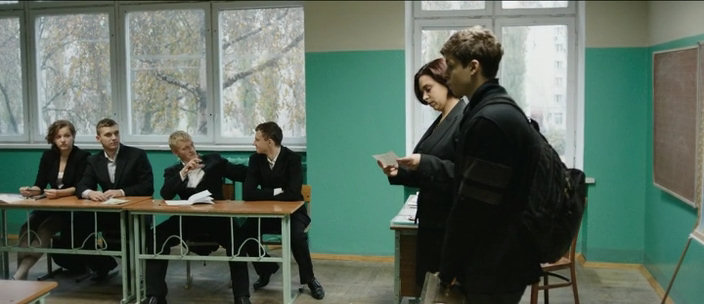Clicking of a pen, drumming of fingers on the desk, sliding of a chair leg, whispering, zipping of a pencil case, clearing of a throat. These are all things that throw a teacher off their game, causing disruption to the flow of their lessons. Or so I thought. But watching The Tribe, a film where the dialogue is communicated completely through signing, my opinion of what amounts to disruption was challenged. Even in complete silence major disruption can be caused.
There is a scene early on in the film where new student Sergey (Grygoriy Fesenko) enters the classroom at his Ukrainian boarding school. Upon entering the room, one of the other students immediately begins to sign to the other students. The student strides his chair, legs spread wide, one elbow resting on the desk, and body leaning slouched upon the seat. And in an instant I realise that it’s never the sound itself that creates disruption; it’s the attitude.
The teacher turns her attention away from Sergey and stares daggers at the teen who is kicking back like a real ‘Mr Coolio’. She tells him to be quiet. He continues to slouch, while spinning his pen nonchalantly in his hand. Again, complete defiance is communicated without a single noise.
Sergey sits down and the teacher begins her geography lesson. Again she is interrupted by the class clown. She requests he stand up. She negotiates with him, comes to some sort of agreement and then he sits down again. The moment she turns to examine the map at the front of the room, he is signing again. The lights flash and it’s time for break.
This scene alone was a revelation for me in regards to my own teaching. Whenever I teach I am on a never ending quest to reach a state of near silence in my classrooms. As though silence will bring about an equilibrium for learning. The Tribe threw that in my face and proved to me that even in a situation where nothing is heard, there are plenty of other ways to rebel. Even if I could sign, I would not work at that boarding school. Not just because of the slouching pen-twirling teenagers, but more due to the violence, drugs and sex that infiltrates the corridors of the dormitories and spills onto the streets.
Director Myroslav Slaboshpytskiy has created an insane community of characters and situations in The Tribe. Despite claims by some critics that this is a silent film, I feel it’s not. The characters are signing with their hands. So there is communication and dialogue occurring. It’s a film with-out subtitles, which presumably means there is another level of depth to the film that would be accessed by those who understand Ukrainian sign language. But for the rest of us, the slow reveal of the plot through gestures and action is what makes this film masterful.
The performance by Grygoriy Fesenko and his co-stars Yana Novikova and Roza Babiy is thrilling. The cast of this film were unknown non-actors who were trained up on set and developed a set of intriguingly broken characters, not limited by their hearing impairment. There are few scenes where their lack of hearing directly affects the action of the film.
The Tribe is no Hollywood teen movie. If an allusion were to be made, then perhaps it is Mean Girls on acid, with a Ukrainian Michael Cera as the lead. While the situations in the film are mostly extreme, it should be an eye-opener for teachers who may wonder why students turn up to class withdrawn or angry. It is a wake-up call for parents who think their children spend time riding horses and playing hockey at boarding school. It will give students some dark and perverted ideas for entrepreneurialism and revenge. For the rest of you it can remind you to read the world through what you see, not just what you hear.
